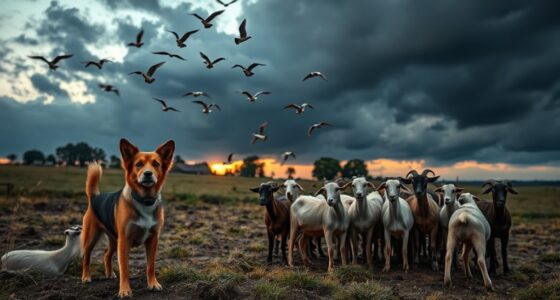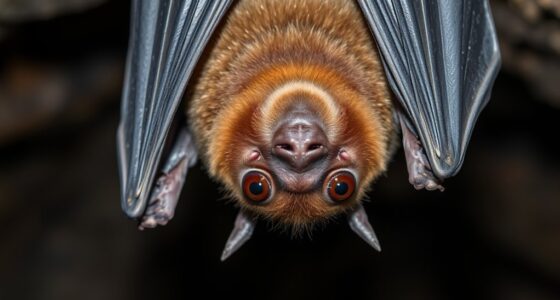Claws play an essential role in animal survival by enhancing predation, foraging, climbing, and defense. They're made of keratin and come in various shapes, tailored to specific needs. For example, raptors use curved claws for capturing prey, while bears have broad claws for digging. These adaptations boost grip and movement, helping animals thrive in diverse environments. Understanding how claw morphology impacts survival can reveal fascinating insights into their evolutionary significance and functionality.
Key Takeaways
- Claws provide essential grip, enhancing climbing ability and allowing animals to navigate complex environments effectively.
- Specialized claw shapes improve efficiency in prey capture and foraging, directly influencing dietary success.
- The morphology of claws varies across species, reflecting adaptations to specific ecological niches and survival strategies.
- Strong, broad claws in some species enable digging for food and shelter, crucial for survival in harsh environments.
- Continuous growth and replacement of claws ensure they remain functional for hunting, foraging, and self-defense against predators.
The Anatomy of Claws and Their Composition

Claws play a crucial role in the survival of many animals, and understanding their anatomy reveals why they're so effective.
In the animal kingdom, claws are primarily made of keratin, a tough yet flexible protein that grants strength for various tasks like digging, climbing, and hunting. Each claw consists of two main parts: the unguis, the hard outer layer, and the subunguis, the softer inner layer that offers support and cushioning.
The morphology of claws—shape, size, and curvature—is tailored to specific ecological niches, enhancing an animal's ability to grasp, cling, or dig. Since claws continuously grow and can be replaced, like cat claws in about two months, they maintain their functionality, ensuring survival in diverse environments.
Functional Adaptations of Claws Across Species

While their primary function may be similar, claws across species exhibit remarkable functional adaptations that enhance survival in diverse environments.
For example, raptors have sharp, curved claws designed for grasping and killing prey, while grizzly bears possess strong, broad claws for digging and foraging.
Climbing species, like tree frogs, boast hook-like claws that improve grip on vertical surfaces.
In mammals, claws can evolve into nails or hooves, offering distinct benefits; nails provide dexterity for primates, while hooves deliver stability for running ungulates.
The diameter and tapering of claws also affect friction with surfaces, essential for clinging, climbing, and capturing prey.
These functional adaptations highlight how claw morphology aligns with ecological needs and behaviors across species.
The Impact of Claw Morphology on Survival Strategies

When examining how animals survive in their environments, it's clear that claw morphology plays an essential role in their survival strategies. The shape and structure of claws directly impact an animal's ability to navigate and thrive.
Here are three key aspects to take into account:
- Climbing Ability: Many climbing species have curved, hook-like claws that enhance their grip on various surfaces, vital for avoiding predators and finding food.
- Grip and Stability: The diameter and tapering of claws influence their grip strength, where narrower tips create more friction, aiding in movement and attachment.
- Locomotion Efficiency: Specialized claw shapes improve clinging force on smooth substrates, enhancing an animal's ability to move swiftly and efficiently, supporting their survival in competitive environments.
Understanding claw morphology helps us appreciate these remarkable adaptations in the animal kingdom.
Claws in Predation and Foraging Techniques

In the wild, effective predation and foraging techniques often hinge on the unique adaptations of claws.
Take raptors like eagles, for instance; their long, curved talons enable them to grasp and capture prey mid-flight. Carnivorous mammals, such as African lions, benefit from protractile claws that retract to maintain stealth while stalking, enhancing their grip during an attack.
Raptors like eagles and African lions showcase how specialized claws enhance their hunting prowess and survival strategies.
Foraging is another area where claws shine; chickens use their short, sturdy claws to scratch the ground, uncovering seeds and insects. Climbing species, like certain lizards, possess curved, hook-like claws that help them cling to surfaces and secure prey in trees.
Ultimately, the efficiency of claws directly impacts survival, reflecting each species' dietary needs and hunting strategies.
Evolutionary Significance of Claw Variability

Claw variability plays an essential role in the survival of different species, reflecting their evolutionary adaptations to diverse environments and lifestyles.
Understanding claw morphology helps you appreciate how these features enhance survival:
- Curved claws in raptors enable efficient prey capture, showcasing a direct link between claw shape and hunting strategies.
- Broad nails in primates facilitate grasping, crucial for maneuvering trees and accessing food sources in arboreal habitats.
- Long claws in grizzly bears allow for effective digging and tearing, illustrating how claw structure adapts to specific foraging needs.
These adaptations highlight the significance of claw variability, emphasizing how different species have evolved unique claw shapes to optimize their functionality and improve their chances of survival in various ecological niches.
Frequently Asked Questions
How Do Claws Help Animals Survive?
Claws play an essential role in an animal's survival. They help you capture prey, dig for food, and defend against threats.
If you're climbing, your claws provide grip on surfaces, making it easier to escape predators.
You'll notice that different animals have adapted their claws to fit their environments—whether for running, climbing, or digging—enhancing their chances of survival.
In many ways, your claws are critical tools that support your daily needs.
What Is the Purpose of the Nail Claw?
The purpose of the nail claw is to enhance your grasping abilities. It allows you to climb, manipulate objects, and perform delicate tasks.
With nails, you get protection for the sensitive tips of your fingers and toes, which helps prevent injuries. They grow regularly, ensuring they stay functional and adapt to wear.
Unlike sharper claws, nails support fine motor skills, essential for grooming and social interactions in your environment.
Why Do Animals Need Sharp Claws?
Imagine if your fingers were equipped with razor-sharp knives—animals need sharp claws for survival, too!
These claws aren't just for show; they help predators catch their next meal, assist herbivores in digging for food, and enable climbers to grasp trees.
Sharp claws act as formidable defenses against threats, ensuring safety in the wild. Without them, animals would struggle to thrive in their environments and maintain their place in the ecosystem.
What Are the Benefits of Claws?
Claws provide you with multiple benefits that enhance your daily activities. They help you grip and manipulate objects, making tasks like climbing or digging easier.
With sharp claws, you can defend yourself against threats or catch food more effectively. They also offer stability, allowing you to navigate various terrains with confidence.
Plus, the unique shape and size of your claws can adapt to different environments, improving your overall efficiency in your surroundings.
Conclusion
In summary, claws play an essential role in animal survival, shaping how species adapt, hunt, and thrive in their environments. For instance, studies show that animals with specialized claws can capture prey up to 50% more effectively than those with less adapted claws. This remarkable efficiency highlights the evolutionary significance of claw morphology, illustrating how these adaptations not only enhance survival but also drive the diversity of life on our planet. So, next time you observe claws in action, consider their important role!










